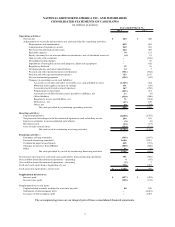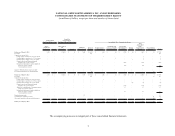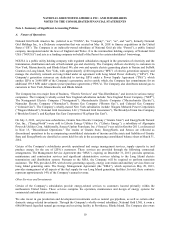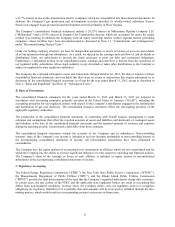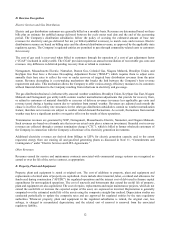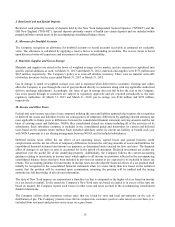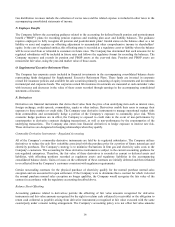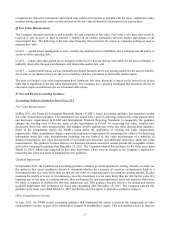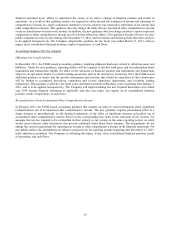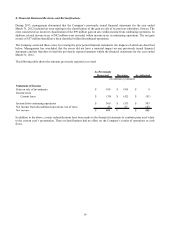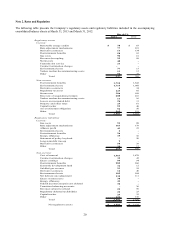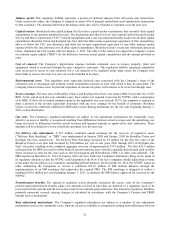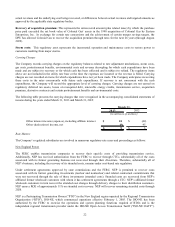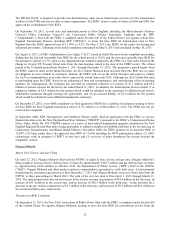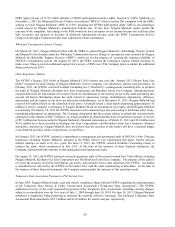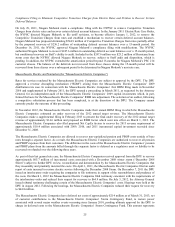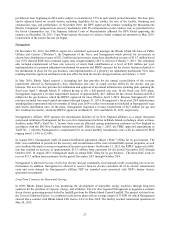National Grid 2013 Annual Report Download - page 18
Download and view the complete annual report
Please find page 18 of the 2013 National Grid annual report below. You can navigate through the pages in the report by either clicking on the pages listed below, or by using the keyword search tool below to find specific information within the annual report.
17
recognized for derivative instruments and related cash collateral receivable or payable with the same counterparty under
a master netting agreement, and to record and present the fair value of derivative instrument(s) on a gross basis.
Q. Fair Value Measurements
The Company measures derivatives and available for sale securities at fair value. Fair value is the price that would be
received to sell an asset or paid to transfer a liability in an orderly transaction between market participants at the
measurement date. The following is the fair value hierarchy that prioritizes the inputs to valuation techniques used to
measure fair value:
Level 1 — quoted prices (unadjusted) in active markets for identical assets or liabilities that a company has the ability to
access as of the reporting date;
Level 2 — inputs other than quoted prices included within Level 1 that are directly observable for the asset or liability or
indirectly observable through corroboration with observable market data; and
Level 3 — unobservable inputs, such as internally-developed forward curves and pricing models for the asset or liability
due to little or no market activity for the asset or liability with low correlation to observable market inputs.
The asset or liability’ s fair value measurement level within the fair value hierarchy is based on the lowest level of any
input that is significant to the fair value measurement. The Company uses valuation techniques that maximize the use of
observable inputs and minimize the use of unobservable inputs.
R. New and Recent Accounting Guidance
Accounting Guidance Adopted in Fiscal Year 2013
Fair Value Measurements
In May 2011, the Financial Accounting Standards Board (“FASB”) issued accounting guidance that amended existing
fair value measurement guidance. The amendment was issued with a goal of achieving common fair value measurement
and disclosure requirements in GAAP and International Financial Reporting Standards. Consequently, the guidance
changes the wording used to describe many of the requirements in GAAP for measuring fair value, requires new
disclosures about fair value measurements, and changes specific applications of the fair value measurement guidance.
Some of the amendments clarify the FASB’ s intent about the application of existing fair value measurement
requirements. Other amendments change a particular principle or requirement for measuring fair value or for disclosing
information about fair value measurements including, but not limited to: fair value measurement of a portfolio of
financial instruments; fair value measurement of premiums and discounts; and additional disclosures about fair value
measurements. This guidance became effective for financial statements issued for annual periods (for non-public entities
such as the Company) beginning after December 15, 2011. The Company adopted this guidance for the fiscal year ended
March 31, 2013, which only impacted its fair value disclosures. There were no changes to the Company’ s approach to
measuring fair value as a result of adopting this new guidance.
Goodwill Impairment
In September 2011, the FASB issued accounting guidance related to goodwill impairment testing, whereby an entity has
the option to first assess qualitative factors to determine whether the existence of events or circumstances leads to a
determination that it is more likely than not that the fair value of a reporting unit is less than its carrying amount. If, after
assessing the totality of events or circumstances, an entity determines it is not more likely than not that the fair value of a
reporting unit is less than its carrying amount, then performing the two-step impairment test is not required. Otherwise,
the entity is required to perform the two-step impairment test. This guidance became effective for annual and interim
goodwill impairment tests performed for fiscal years beginning after December 15, 2011. The Company adopted this
guidance in its fiscal year ended March 31, 2013 and did not elect the option to perform a qualitative analysis.
Other Comprehensive Income
In June 2011, the FASB issued accounting guidance that eliminated the option to present the components of other
comprehensive income as part of the statement of changes in stockholders’ equity. This new guidance seeks to improve


